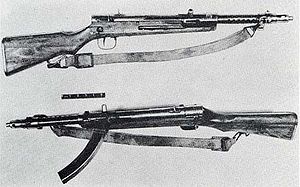Type 100 submachine gun
| 100 Shiki Kikan-tanju | |
|---|---|

Type 100 (1944)
|
|
| Type | Submachine gun |
| Place of origin |
|
| Service history | |
| In service | 1942–1954 |
| Used by | See Users |
| Wars |
Second Sino-Japanese War, Second World War, Indonesian National Revolution, First Indochina War, Korean War (limited usage), Malayan Emergency Vietnam War (limited usage) |
| Production history | |
| Designed | 1939 |
| Produced | 1942–1945 |
| Number built | 24,000–27,000 |
| Variants | Type 100/40 (with solid stock) Type 100/40 (with folding stock) Type 100/44 (with solid stock) |
| Specifications | |
| Weight |
3.8 kg (8.4 lb) (1942, empty) 3.4 kg (7.5 lb) (1944, empty)4.4 kg (9.7 lb) (1944, loaded) |
| Length | 890 mm (35.0 in) (1942) 900 mm (35.4 in) (1944) |
| Barrel length | 228 mm (9.0 in) (1942) 230 mm (9.1 in) (1944) |
|
|
|
| Cartridge | 8×22mm Nambu |
| Caliber | 8 mm |
| Action | Blowback |
| Rate of fire | 450 rounds per minute (1942) 800 rounds per minute (1944) |
| Muzzle velocity | 335 m/s (1,100 ft/s) |
| Effective firing range | 100-150m |
| Feed system | 30-round detachable curved box magazine |
3.8 kg (8.4 lb) (1942, empty)
The Type 100 submachine gun (一〇〇式機関短銃 Hyaku-shiki kikan-tanjū?) was a Japanese submachine gun used during World War II, and the only submachine gun produced by Japan in any quantity. It was made in two basic variants referred to by American and British observers as the Type 100/40 and the Type 100/44, the latter also known as the Type 100 (Simplified). A third variant was a folding version of the early model, sometimes referred to as the Type 100 Navy, made for parachutists.
Designed and built by the Nambu Arms Manufacturing Company under a low-priority military contract, the Type 100 was a submachine gun that was first delivered to the Imperial Army in 1942. Japan was surprisingly late to introduce the sub-machine gun to its armed forces — a few models of the SIG Bergmann 1920 (a licensed version of the German MP 18) were purchased from Switzerland in the 1920s. These were examined and copied, with significant changes. In 1942 the Type 100 SMG was first delivered for service, used by Japanese marines during the invasion of Southern China.
The Type 100 was typical of the class of simple, inexpensive, wartime submachine guns produced by all military powers—designed for maximum ease of production. It is based on a simplified Bergmann MP18, modified for the 8mm Nambu round. It was an automatic-only, air-cooled, blowback weapon firing from an open bolt and feeding from a side-mounted, 30-round detachable box magazine. The barrel was given six-groove, right-hand-twist rifling. Unusually for a submachine gun (but typical of Japanese weapons of the era), a bayonet lug was fixed under the barrel, in this case with a heavy bar and lug. Some of these models featured a bipod, and others featured a complicated muzzle brake.
...
Wikipedia
